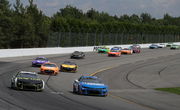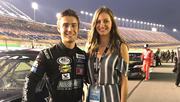

The driving force for any driver on the track at NASCAR combats is none other than the powerful engines. But were the engines always this powerful? There was a time when the engines were not modified much, only slight changes here and there when they were purchased. However, the rise in powerful engines started during the tenure from 1950 to 1960 when teams just wanted to chase power and make the cars stronger than ever.
Remember Hudson Twin-H which had risen to a pompous growth? NASCAR has been very particular with its engine optimization and it has constantly updated the norms. With drivers currently demanding an increase in horsepower, Joe Gibbs Racing shared how the engines have revolutionized with time.
ADVERTISEMENT
Article continues below this ad
Engine editions at NASCAR through the years
NASCAR has been a sport that has seen the rise and fall of some of the most phenomenal along with deplorable car engines. The 50s started with the Hudson Twin – H and this one was known for the valor it could handle. Drivers could race without having to worry about the implications it could have on the engines. This one was fairly light and was bulletproof as well. The engines at the time could handle 200 horsepower. The leap from the Hudson to the legendary Cammer Ford was Swift and yet drastic. This one was a phenomenal concept and was a side oiler 427s. The rise to horsepower for this one was about 600 horsepower.
However, soon, these engines were put on a ban and a modern era took over. The limit was set on the aero cars by NASCAR. While delving deeper, Joe Gibbs Racing put forth, “At this point, NASCAR had also limited horsepower on the new “aero car” to help offset their aerodynamic advantage. By the 80s, cars were making in the ballpark of 600 to 650 horsepower. In 1987, qualifying records were set at over 210 miles per hour at both super speedways Daytona and Talladega.”
NASCAR drivers are now at a tassel with NASCAR, given that they want an increase in the horsepower capacity of the cars. An increase in horsepower would imply that one could chase a higher speed on the tracks. The year 2014, saw a slight increase in the horsepower capacity of the cars. The electronic fuel injection system had taken over the carburetors at this point and this had ensured that the cars could climb to 900 horsepower.
View this post on Instagram
The rise to 900 horsepower for Cup Series cars had led to a test drive in Michigan which saw the speed rising to 217 miles per hour. This was by far one of the highest speed records for NASCAR. Consequently, this didn’t do much as the tapered spacer made its entry in 2015. The major aim of this introduction was to inhibit the airflow which would take down the horsepower to 750 and thus inhibit speed more. In 2019, this reduced further to 550. How did it impact cars? Joe Gibbs Racing pointed out, “pole qualifying times at Michigan were over three and a half seconds slower in 2019 than they were in 2014”.
What’s your perspective on:
Should NASCAR listen to drivers like Joey Logano and boost horsepower for a more thrilling race?
Have an interesting take?
The changes in the engine power hasn’t been well received by NASCAR fans. This was exemplified by Joey Logano’s comments.
ADVERTISEMENT
Article continues below this ad
Trending
When Joey Logano advocated for higher horsepower
The present-day situation is such that engines have the capability of pushing to 670 horsepower at the maximum only. The limit came with NASCAR’s experimentation to reduce overall costs but hasn’t been met with much prospect from drivers. While the debate has been ongoing to improve the horsepower that can impact the speed. The use of engines has also now turned into one for the entire race weekend compared to previous times when teams would use one for practice and one for the actual race.
This ongoing limitation on horsepower has left drivers advocating for an increase, as they believe it would not only enhance the thrill of the sport but also allow them to push the boundaries of performance and speed on the track. NASCAR is a sport that is known for the adventure and thrill it holds. The ones who are at the lead for bringing this thrill to the audience are none other than the drivers. Joey Logano, the third-time NASCAR Cup Series champion was also of a similar opinion where he sided with those who demanded higher horsepower for the car. He had been quite vocal about the same in an interview as well.
ADVERTISEMENT
Article continues below this ad
Logano said, “We want more power. It increases tire wear. It makes the track wider. And it’s more badass”. Logano also mentioned that while the current horsepower for the cars is set at a comfortable 670 at its peak, shifting to 750 at the most should not be an issue. He further added, “I don’t know where it all comes from; to be honest with you, I think there’s I don’t know who leads the low horsepower band, but I could promise it was not the drivers because I think every one of us wants to have more power”.
Logano’s push for higher horsepower highlights his vision for a more exciting and challenging NASCAR experience. By advocating for increased power, he aims to elevate the stakes for drivers and amplify the drama that keeps fans on the edge of their seats, ensuring that the sport continues to push the limits of speed and skill.
ADVERTISEMENT
ADVERTISEMENT
ADVERTISEMENT
ADVERTISEMENT






Should NASCAR listen to drivers like Joey Logano and boost horsepower for a more thrilling race?